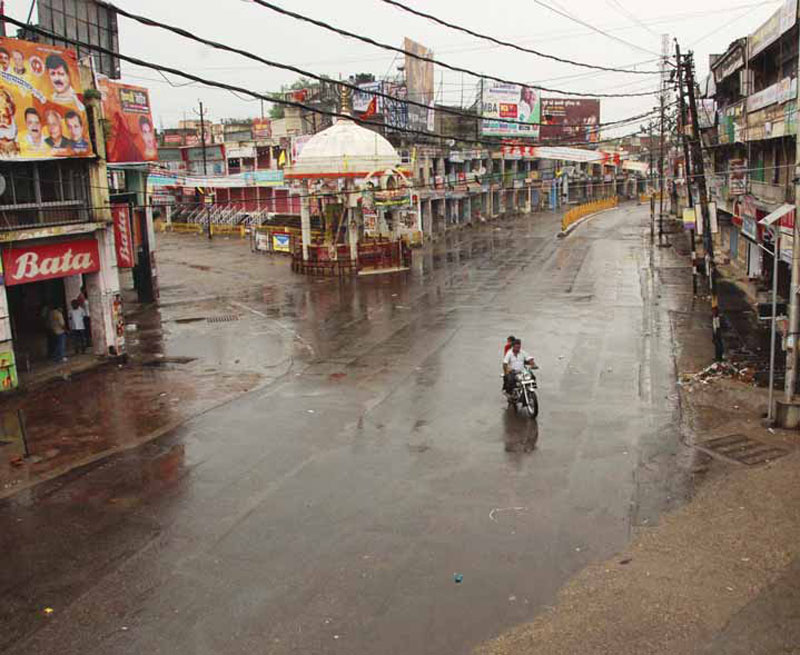Amid the green-revolution-borne extractionist abundance of Western UP, local life remained steeped in stagnant, rotting inertia… until the fascists of the Sangh Parivar decided this was fertile ground for breeding and harvesting the communal hostility they needed to fuel their insurgency…. Amit Sengupta writes…
This is Omkara territory, the wild west of Western UP, where sensuality ends… only to never begin. A coarse quagmire of life’s stasis moves in eternal stagnation, often barren despite the lush green fields and the mustard blossoms of the green revolution belt. Here, the twilight zone moves into the sudden criminality of unexpected dangers lurking in the evening, as the dry, dusty sun sets over puddles of dirty, lingering, rotting waters on the streets lined with solid brick homes with no windows or doors.
The complex trajectories of crime, petty power struggles, caste politics and muscle power moves unchallenged after dusk in parts of this landscape; those who must pass on the highway or through the zigzaging, primitive, muddy by-lanes, must reach their destination before sunset. Not that mornings or afternoons are always full of absolute security or peace; the diabolical and the deadly can re-fix their gaze even in cold daylight. But the dark much worse.
This is truly Omkara territory, where the time and space spiral moves in repetitive retrograde motions, suspended between a feudal and patriarchal Bahubali body clock, almost removed from the ceaseless motions of modernity’s insatiable desires.
The closed doors of perception. The rigid architecture of stasis. The staccato soliloquy of words, silences and hookahs, hiding the moistness and sweet smell of the sugar cane fields and the first liquid jiggery whose perfume fill the air. The simplicity of ordinary folk; if they like you, they will force you to have an extra sweet cup of tea with a handful of sweeter laddoos or barfis cooked in desi ghee.
In its simplicity and its rough stillness, this is a timeless kind of change, itself unchanged, where the open gutter on the street, or the rotting pile of banana skins next to a jalebi cart with a buzzing collective of flies, or an ancient film hoarding featuring a buxom female together work out an anti-cathartic kaleidoscope – even as the long caravan of bullock carts carrying stacked sugar canes move into their long nocturnal journeys through agricultural fields towards crisis-ridden sugar factories.
If you travel through the Baghpat-Baraut-Muzaffarnagar- Shamli belt of Western UP as a traveler, you’d be reminded of a story Ruskin Bond had written in a daily paper in the 1990s. His bus once stopped at the sad Shamli bus stand, with rotting garbage and the stink of piss all over. He went to the small book shop piled with colourful Hindi pulp fiction. He saw a sexy Shobha De bestseller and Khushwant Singh’s book of jokes on top of a pile of books. He also saw, miraculously, a book written by Ruskin Bond down below, hidden in the heap. Clandestinely, he picked up his own book and placed it on top of the pile of books, above that of Shobha De’s books and the book of jokes. On his way back, he once again stopped at the Shamli bus stand and casually walked across to the same book shop. And what did he find? The Ruskin Bond book was once again placed at the bottom of the heap, tucked into its original domain of obscurity.
Indeed, not much has changed in this part of the world since this Bond episode at Shamli. And life would have gone on in its own insipid, arid, effortless bullock cart space, if the Sangh Parivar had not systematically and willfully engineered the riots in Muzaffarnagar and Shamli and beyond – to the lush green hinterland, across the architecture of stasis and stagnation. Indeed, for more than two decades, there has been not one single act of violence enacted as a spectacle in this twilight zone dominated by the Jat community, with strong populations of Muslims, Gujjars, Brahmins and Dalits all making up parts of the ethnic mapping. The caste and community divide was incipient, but there was no open hostility, no discernable bad blood, not even a struggle for land or territory. In its own manner of retreat and reconciliation, this slow zone of feudal patriarchy enacted its daily ritualism without an iota of recrimination or violence.
And yet, when the sinister, diabolical and xenophobic forces entered, everything changed, and so rapidly, that between one village and another, between Jats and Muslims – the conflict has never been between all Hindus and Muslims nor between Muslims and any other communities– that the old, ritualistic architecture collapsed in a moment and all the dark memories of Partition came alive like a film in sepia rewind.
Thousands were displaced, moving from one sugarcane field to another, from villages to open air camps,– most of them Muslims, contrary to the RSS/VHP/BJP goons and leaders activated their time-tested and vicious propaganda models based on communal polarizations and social engineering. That they got tacit and tangential backing from a rudderless regime in UP, and a clueless district administration, only added to the divisions, the mass exodus, the murders, and the unwritten stories of rapes which stalked the land, even while many of the rapists, till this day, roam free for all to see.
The bustling moffusil town of Muzaffarnagar and the filthy bus stand at Shamli are now full of stories of division and hatred. The xenophobes led by Amit Shah as strategist have succeeded and the entire State apparatus and its police and intelligence agencies knew much in advance, that communal polarization is the ultimate electoral trump card of that fascists who want to enter Delhi via UP. If they have a chance, they will do it all over UP and all over India.
That they succeeded here, and yet again got away, even as the alleged criminals were felicitated in Narendra Modi’s rally, is an indication that the Indian State and civil society has decisively lost even this battle with the fascists. Surely, for the thousands displaced who still live in the open in this early, cruel winter of Western UP, and those who mourn their dead, and those women whose bodies have been ravaged, this will mark a defining moment in the history of India’s pseudo secular democracy. This is because once again, it was Tamas, written all over the landscape, in this mass tragedy of our times.


